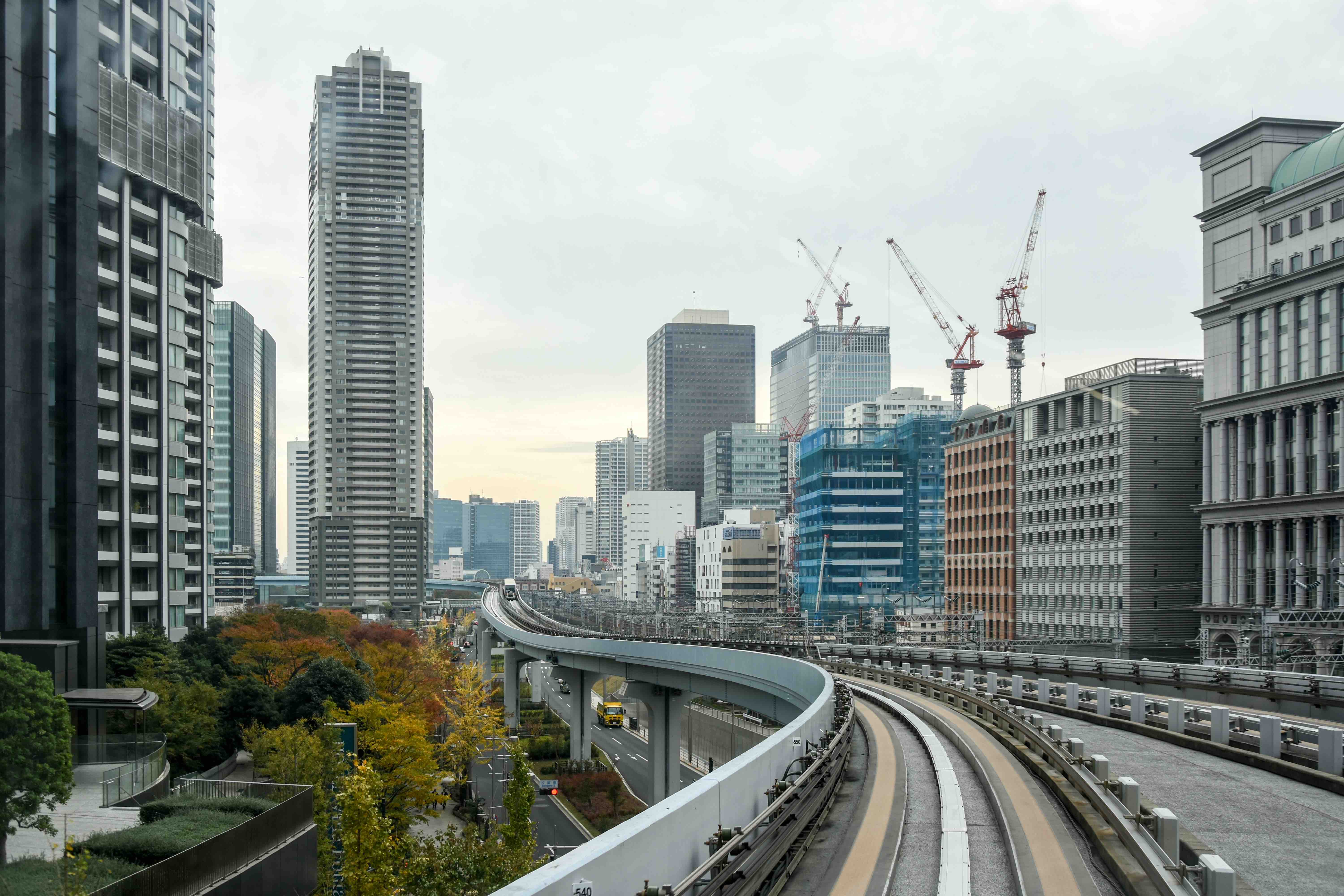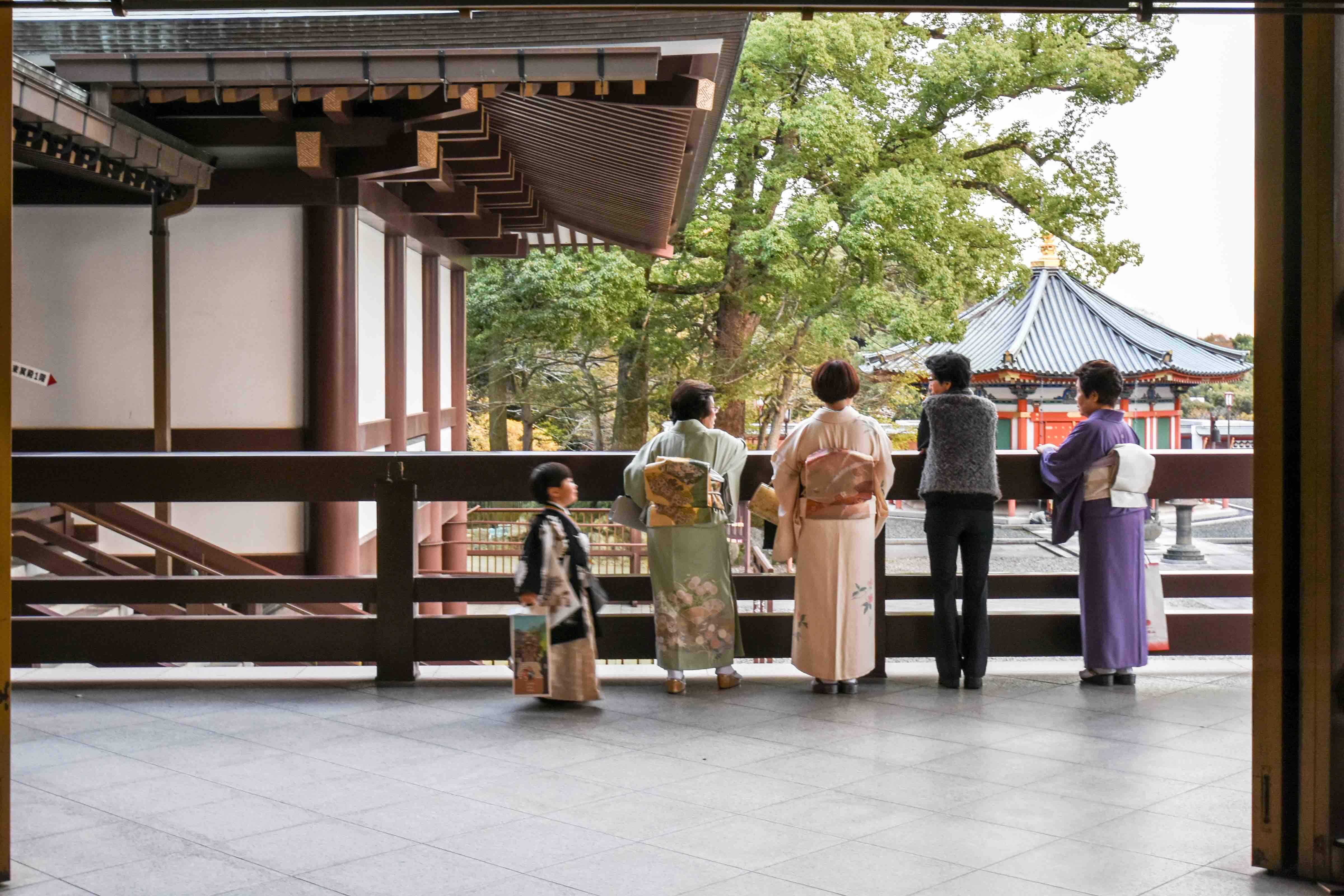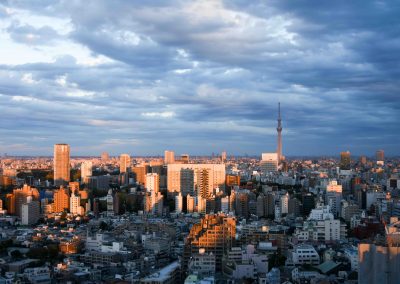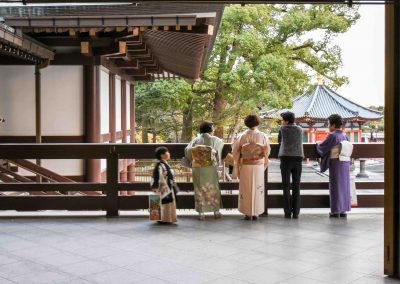I was on Japanese soil from November 10th to 24th, so I also focused a lot on looking for autumn colors (koyo). We bought a JR Pass for 7 days, which obviously conditioned us the trip a lot, and we chose to use it in the middle of the trip. For those who do not know the JR Pass is a transport pass that lets us ride on almost all JR (Japan Rail) trains and buses and is almost always the cheapest solution to travel within cities, unless you choose night buses to go from a city to another.
Arrival at Narita Airport in the evening. To go to Tokyo it still takes about an hour and a half of transports. Before leaving the airport, buy the PASMO card, a card you can charge with cash and serves all over Japan. In the end you can return the card and they will refund you the 500 yen it costs to issue it and the money you still have on it. Check Google Maps for the cheapest way to get to your accommodation – Google Maps is (almost) always your saviour (read “Internet in Japan“)!
Start the day in the historic area of Asakusa. Take advantage of the jet lag to start the day early, since at this time of year the sun sets at 4.30pm. Nakamise dori is a little street that precedes Sensoji temple and gives us an idea of the gastronomy and souvenirs that we will find in the next days. This temple is the oldest in the capital. From there we crossed the Sumida River and walked to Tokyo Skytree, now the second tallest building in the world. Our plan was to visit the existing Pokemon Center in the mall at the base of the telecommunications tower and not going up the tower, as we would later visit a panoramic building which was free. We then took the subway to Ueno, to have lunch at Ameyoko Market and later visit Ueno Park, a little bigger than I imagined and with many temples on its grounds. We ended the day at the Bunkyo Civic Center, the free panoramic building, and we arrived just in time for watching the sunset behind Mount Fuji. As we were sleeping in an Airbnb in the Shinjuku neighborhood we looked for a place to dinner between Golden Gai and Kabukicho, the supposed red light district of Tokyo. From girls we did not see anything, maybe because it was still early, but the neighborhood was not the best and we later read that it would not be advisable for women to walk around the neighborhood by themselves and that it is very easy to be deceived. At least we were accompanied.

First adaptation of the plan. We had planned to go to Tsukiji Fish Market but luckily the night before I did some research on the market and realized that it was closed on Sundays, so we could not visit it that day. I thought I could just change the plans of day 3 to day 4 but on day 4 we had the visit to the Imperial Palace, which in closed on Mondays, so we had to adapt the two days. We started with the palace, or rather with its gardens, since the emperor lives here and the doors only open twice a year, on his birthday and on the 1st of January. We had lunch at Tokyo Station, very famous for its ramen restaurants, and where we exchanged the JR Pass vouchers for the tickets themselves. From there we walked to Ginza, which on Sundays has no cars on its main avenue. A street with a lot of life and beautiful architecture. We ended the day in the electric town of Akihabara, where gamers can find, with some patience, everything they are looking for. This is also where the maid caffees are, with girls on the street dressed like their favourite characters, who try to convince us that their caffee is the best. We ended up not going into any because they all require a fee just to get in, beyond consumption, at above average prices.

We started the day at the Tsukiji Fish Market, which is divided into several areas, more or less touristic. In the market itself, tourists are only allowed to enter after 10am, so as not to affect trade, but at this time there is almost nothing left to see. Outside, several little streets are filled with small stalls selling everything, although at higher prices than we expected. As we had read, this is where we should eat our first sushi. I must say it was a disappointment, since I’m not a fan of wasabi and the sushi came by default with this green paste, besides quite expensive … From there we took the metro to visit the Meiji Shrine, a sanctuary dedicated to the ancient Meiji emperor and his wife. It’s amazing how, in a mega metropolis, we’re suddenly in the middle of the forest! Next to it there is the neighborhood of Harajuku, one of Tokyo’s most popular neighborhoods, although we were expecting to see a lot of people in cosplay and we saw only one old lady at Takeshita Dori. We continued along Omotesando Avenue, a must visit for architecture lovers, since here we can find works by Toyo Ito, SANAA, MVRDV or Herzog & de Meuron. We walked until SunnyHills store in Minami-Aoyama, designed by Kengo Kuma, who offers a sampling of its Taiwanese pineapple cake and a tea that blends perfectly with the cake. We ended the day in the Shibuya neighborhood, at the world’s busiest intersection.

On this day began counting our 7 day JR Pass. At 8:33am we were taking a Shinkansen (bullet train) bound for Kyoto. It rained. The journey takes about 2h15min, but we did not expect to take so long to arrive from the train station to our hostel in the Ginkakuji Temple neighborhood, which took us 40min by bus. As most temples close very early (between 4pm and 5pm) we decided to visit the nearby temples,Ginkakuji and Nanzenji. after walking the Philosopher’s Path between one and another. Already after the sun set (in Kyoto it was a little later, around 5:00 p.m.), we went to Nishiki Market in the city center. The market also closes early, at 6pm, but we still managed to get to see it, before looking for a place to have dinner.

We woke up early to try to reach Fushimi Inari with few people. In spite of being quite full, on the return we realized that we had found the temple “empty” comparatively. It is here that there are more than 3,000 toriis lined up and it was one of the places we liked the most. A lot, but a lot, bigger than we imagined. We walked for about three hours and could only see half of the course. Kyoto has a daily pass for buses, which costs ¥500, and it pays off after the third trip. What we did not know is that to get to Fushimi Inari we would have to catch a train, so that day it did not compensate us to buy the daily pass. In the same train line passes a JR train, so you can go there without paying if you have the JR Pass. Still in the temple grounds there were many food carts with typical japanese food and that’s where we had lunch. We took the train back to visit Kiyomizu-dera Temple (which is under construction until 2020). Still worth a visit, not only for the way to get there, but also for its surroundings, as it is on the edge of the city with the mountains. Here we begin to see many asians in kimono – mostly tourists from China, Korea and Taiwan. We descendes through the Higashiyama neighborhood, with its typical wooden houses and the Yasaka tower, for the traditional photo of the neighborhood. We ended the evening in Pontocho, by the river, looking for a place to have dinner, which we ended up finding closer to the city center.

Nara is approximately one hour away from Kyoto and is the capital of Buddhism in Japan and home to one of the largest Buddha statues in the world. However it is best known for the city of deer, which circulate freely through the streets. There are sellers of deer “biscuits,” but most who buy them spend more time fleeing the starving deer, who patiently hit people with their heads, than to actually feed them. The trick is to only have one biscuit in the hand at a time and the other ones hidden in your backpack. The most famous temple is Todai-ji, where the big Buddha is found. There are also the Isuien Gardens, which we did not visit because we thought that what they asked for at the entrance was too high. We had planned a whole day for Nara but at 2:00 PM we were back in Kyoto and we took the opportunity to visit the Imperial Palace, which had been pending in our plan for lack of time on the first day in Kyoto. This palace is from the time Kyoto was the capital of Japan and is still used for the inauguration ceremonies of the new emperor. That night we had sushi, in an excellent carpet sushi restaurant, right in the center!

The day started a bit later than anticipated because we needed more than an hour bus ride between our hostel and Arashiyama. We quickly found the bamboo forest, still with few tourists, but it was the biggest disappointment of the trip, with a short and interrupted way of bamboos. We explored the city and the temples we met on the way and then came back near the bamboo forest to visit Tenryu-ji Temple. We crossed the river afterwards, because my sister wanted to go to Kameyama-koen Park, to see the local monkeys, but we thought it was not worth it after seeing the price and some photos. We then took a bus to the golden pavilion Kinkakuji, the most beautiful and different we saw in Kyoto, although crowded with tourists. We ended the day in the neighborhood of Gion, where I saw two geishas (or geisha apprentices, I really do not know) and it was a great emotion!

This day we were already sleeping in Osaka and so we decided to spend the day in Hiroshima. The Shinkansen from Kyoto to Hiroshima takes approximately 1h40. As soon as we arrived we found a place where we could leave our luggage. In all stations there are lockers of varying sizes but at Hiroshima station there is also a kind of luggage rack, cheaper, the only difference being that it closes at 6pm and so you have to go get your bags before that. We then went to Hiroshima Castle, our first castle in Japan. We chose not to go inside because we didn’t have much time, and continued to the Peace Memorial Park, where you can find the A-Bomb Dome, the children’s monument , the cenotaph and the Museum of Peace. We stopped there for a while, raptured in what society is capable of doing to itself. From there we caught a bus and then a JR train to Miyajimaguchi to visit the island of Miyajima. Also the ferryboat is included in the JR Pass and passes just in front of the great tori of the Itsukushima shrine. It was only on land that I realized that this place is also full of deer, although there are no biscuits sellers here, so these deers follow any food that tourists may have. The temple of Itsukushima, all orange, was the one I liked to visit the most, probably due to its idyllic location. You must know the tide time before you visit it, depending on what you prefer. I thought I was still going to find some water, because there were still two hours left until the low tide, but there was already no water. I had planned to visit Momijidani Park, but unfortunately the sun was already setting and we had to return to Osaka. Still at the Hiroshima station we had Okonomiyaki, apparently very typical of the region, a kind of fried pancake, which I liked a lot!

The night before, on arrival, we just went to the apartment to sleep. The next morning, Sunday, we woke early, as usual, and the city seemed deserted. It was only in Dotonbori that we began to see some movement. Queues and queues of people who wanted to break fast with the local specialty, Takoyaki, fried octopus. We visited the entire Namba area, from the shopping streets, where we found the much-desired Japanese cheesecake Rikuro, to Den Den Town, equivalent to the Akihabara of Tokyo. This is on the way to the Shinsekai district, famous for kushikatsu (fried skewers with everything you can imagine), and the Tsutenkaku tower, right in the center. It was also in Osaka that we saw balloon fish sashimi – that fish that can only be treated by super professionals, because there is the risk of being poisoned. On our way to this neighborhood we passed the Shintennoji Temple, which I had read that was the only one worth seeing, compared to the ones we had visited in Kyoto. Even this one is not worth seeing, in my opinion. I would have preferred to go to Osaka Bay. The next thing to visit would be the Osaka Castle, but after ten intense days of traveling, the body asked for rest. At night we went back out to the Dotonbori neighborhood, with even more movement at night and all its neon lights on. We loved Osaka!

This was our 7th day of JR Pass, which meant we were sleeping in Tokyo again this night. The plan was to spend the day in Himeji to visit the “white egret,” the biggest castle in Japan, and hence the option the previous day of not visiting Osaka Castle. Still we wanted to see it, so we took the subway to one of the stations on the JR Loop line, which passed near the castle, always above ground, and still left us at the central station of Osaka. From Shin-Osaka to Himeji, depending on what type of Shinkansen, it can take between 30min to 1 hour. As soon as we leave Himeji station we see the castle at the end of the avenue. We had a delicious Donkatsu (a breaded steak over rice with egg – better the flavour than the explanation!) in the way to the castle and we managed to visit it quietly, there were not so many tourists. We even had the surprise of finding a “shy” blooming cherry tree in November!!! At sunset we returned to the station, grabbed our suitcases, left in the lockers, and returned to Tokyo, about 3 hours long.

For the last few days in Tokyo we had not made plans. We wanted to go back to some places we liked the most or where we wanted to buy things to bring to Portugal, or explore personal tastes and spend some time separated, each one looking for what interests him/her the most.
On the first day back in Tokyo we went back to the Tsukiji Fish Market, because my sister, a pastry chef and a cook, wanted to buy some ingredients to bring to Portugal. Then we went back to Ginza, which Jorge did not know yet, since he had gone to Akihabara earlier the last time. It was funny to see Ginza during the week, with cars and lots of people, but in fact I advise going on a Sunday. We spent some time in this neighborhood because I found a Nikon store and decided to leave my camera cleaning, which desperately needed. When it was finally ready we returned to Akihabara, because we had not yet seen the neighborhood by day and because the previous time I was too tired to enjoy. We spent some time in the Mandarake Complex and then in Bic Camera, where I bought a perfect backpack for traveling with the camera and a new lens, ideal for architectural photography, costing 2/3 of the price in Portugal!

On this day, and with my new lens, I could not do anything else than photographing architecture! I started the day at the Tokyo Metropolitan Government Building, a building with two free panoramic towers, near Shinjuku, where we were staying again. The visibility was not the best that day, but it was also interesting to visit and see Tokyo from above, this time during the day. From there I took a train to Koenji to see the House NA, designed by the Japanese architect Sou Fujimoto. I expected a much more residential neighborhood but I found a rather alternative area, still with lots of neon lights. Seeing the house itself was a dream! The next step was to go to the Shimbashi station, where the Yurikamone line begins, a surface train line with no conductor that passes through the Rainbow Bridge and the artificial islands of Tokyo. It is obviously essential to go in the first carriage, in the front seats, to get the best pictures. I made the whole line in one direction and then I picked up the same return line, where I left at Shibaura station to photograph a building by the architect Kazuyo Sejima. I really enjoyed watching the canals of Tokyo. The day ended in Shibuya, where I met Clara and Jorge to make some final shopping.

The day started late, but it was still productive. The body demanded rest and outside it was raining cats and dogs. We had to return to Shibuya because we wanted to return a book that we bought wrongly. Oddly, as we exited the subway, it was a splendid day of sunshine, without a single cloud in the sky. We walked to Harajuku, hoping to see some cosplay, but again we did not find it. This neighborhood was one of our favourites to visit. More alternative shops, mansions, tranquility! We headed back to Sunny Hills. We could not leave Tokyo without eating this delicious pineapple cake again! It is also worth visiting the bathroom, the detail that the architect Kengo Kuma did not forget! We walked to Roppongi, hoping to find the Doraemon statues that were exposed in this neighborhood last year. We found them inside a museum. The neighborhood itself is famous for its luxury shops and lighted trees all year round. Also from here you can see the Tokyo Tower, a copy of the Eiffel Tower. For our last dinner in Tokyo, and back to Shinjuku, we went to the Piss Alley (Omoide Yokocho), an alley with many small restaurants where the specialty is yakitori, grilled skewers. Then we met a Japanese from Hiroshima, who spoke little English, but who gave us the taste of a local brandy, mixed with beer, after seeing us looking at his drink, intrigued. Too bad that the contact with the locals is so timid, since it is not common to find people who speak English fluently.

Our flight was only at night but we had to leave the Airbnb in the morning. We then decided to spend the day in the city of Narita, where the airport is located. The first problem was finding lockers for the suitcases. For a city with an airport they should be better prepared. We ended up finding only one locker so we had to walk with the rest of the suitcases all day. We wanted to visit Narita-san temple and we had read that between the station and the temple there was a street, Omotesando (as in Tokyo, but nothing to do with it), with many shops and restaurants. We walked for a good while, we hardly saw restaurants or shops. Then we found a restaurant that caught our eye. We had lunch. When we left the restaurant, we walked another 100 meters and realized that after all Omotesando Street was only part of the route. Typical wooden houses, as in Kyoto, many restaurants, which sold the local specialty, eel skewers. We also saw three men preparing them – and killing them right in front of us in the process of preparation. We arrived at the temple, thousands of stairs! Impossible to do it with the suitcases. I went up and love it! I came to call them, they had to see this temple. Only my sister came, so we decided to explore also the gardens behind the temple. Take a map or you get lost! The fall colors were super vibrant and it was the best possible farewell from Japan! Unfortunately it was time to go home.

If you liked this post and want to read more about my trip to Japan, you can visit the following posts:




